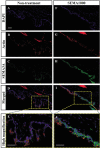Semaphorin 3A controls allergic and inflammatory responses in experimental allergic conjunctivitis
- PMID: 25709899
- PMCID: PMC4325233
- DOI: 10.3980/j.issn.2222-3959.2015.01.01
Semaphorin 3A controls allergic and inflammatory responses in experimental allergic conjunctivitis
Abstract
Aim: To assess the efficacy of topical Semaphorin-3A (SEMA3A) in the treatment of allergic conjunctivitis.
Methods: Experimental allergic conjunctivitis (EAC) mice model induced by short ragweed pollen (SRW) in 4-week-old of BALB/c mice, mice were evaluated using haematoxylin and eosin (H&E) staining, immunofluorescence and light microscope photographs. Early phase took the samples in 24h after instillation and late phase took the samples between 4 to 14d after the start of treatment. The study use of topical SEMA3A (10 U, 100 U, 1000 U) eye drops and subconjunctival injection of SEMA3A with same concentration. For comparison, five types of allergy eyedrops were quantified using clinical characteristics.
Results: Clinical score of composite ocular symptoms of the mice treated with SEMA3A were significantly decreased both in the immediate phase and the late phase compared to those treated with commercial ophthalmic formulations and non-treatment mice. SEMA3A treatment attenuates infiltration of eosinophils entering into conjunctiva in EAC mice. The score of eosinophil infiltration in the conjunctiva of SEMA3A 1000 U-treated group were significantly lower than low-concentration of SEMA3A treated groups and non-treated group. SEMA3A treatment also suppressed T-cell proliferation in vitro and decreased serum total IgE levels in EAC mice. Moreover, Treatment of SEMA3A suppressed Th2-related cytokines (IL-5, IL-13 and IL-4) and pro-inflammatory cytokines (IFN-γ, IL-17 and TNF-α) release, but increased regulatory cytokine IL-10 concentration in the conjunctiva of EAC mice.
Conclusions: SEMA3A as a biological agent, showed the beneficial activity in ocular allergic processes with the less damage to the intraocular tissue. It is expected that SEMA3A may be contributed in patients with a more severe spectrum of refractory ocular allergic diseases including allergic conjunctivitis in the near future.
Keywords: Semaphorin 3A; cytokines; eosinophil infiltration; experimental allergic conjunctivitis; instillation; serum total IgE; subconjunctival administration.
Figures






Similar articles
-
Semaphorin 3A inhibits allergic inflammation by regulating immune responses in a mouse model of allergic rhinitis.Int Forum Allergy Rhinol. 2019 May;9(5):528-537. doi: 10.1002/alr.22274. Epub 2018 Dec 31. Int Forum Allergy Rhinol. 2019. PMID: 30597767
-
Subconjunctival injection of human umbilical cord mesenchymal stem cells alleviates experimental allergic conjunctivitis via regulating T cell response.Stem Cell Res Ther. 2023 Oct 2;14(1):281. doi: 10.1186/s13287-023-03484-4. Stem Cell Res Ther. 2023. PMID: 37784129 Free PMC article.
-
Topical Application of Interleukin-28A Attenuates Allergic Conjunctivitis in an Ovalbumin-Induced Mouse Model.Invest Ophthalmol Vis Sci. 2016 Feb;57(2):604-10. doi: 10.1167/iovs.15-18457. Invest Ophthalmol Vis Sci. 2016. PMID: 26886894
-
Topical Administration of β-1,3-Glucan to Modulate Allergic Conjunctivitis in a Murine Model.Invest Ophthalmol Vis Sci. 2016 Mar;57(3):1352-60. doi: 10.1167/iovs.15-17914. Invest Ophthalmol Vis Sci. 2016. PMID: 27002295
-
Periostin deletion suppresses late-phase response in mouse experimental allergic conjunctivitis.Allergol Int. 2019 Apr;68(2):233-239. doi: 10.1016/j.alit.2018.09.007. Epub 2018 Nov 9. Allergol Int. 2019. PMID: 30420208
Cited by
-
Semaphorin3A: A potential therapeutic tool in immune-mediated diseases.Eur J Rheumatol. 2018 Mar;5(1):58-61. doi: 10.5152/eurjrheum.2017.17076. Epub 2017 Dec 7. Eur J Rheumatol. 2018. PMID: 29657877 Free PMC article. Review.
-
Effects of carvedilol reduce conjunctivitis through changes in inflammation, NGF and VEGF levels in a rat model.Exp Ther Med. 2016 May;11(5):1987-1992. doi: 10.3892/etm.2016.3140. Epub 2016 Mar 10. Exp Ther Med. 2016. PMID: 27168839 Free PMC article.
-
Semaphorin 3A: A potential target for prevention and treatment of nickel allergy.Commun Biol. 2022 Jul 7;5(1):671. doi: 10.1038/s42003-022-03641-0. Commun Biol. 2022. PMID: 35798870 Free PMC article.
-
Interplay between sympathetic nervous system and inflammation in aseptic loosening of hip joint replacement.Sci Rep. 2018 Oct 30;8(1):16044. doi: 10.1038/s41598-018-33360-8. Sci Rep. 2018. PMID: 30375409 Free PMC article.
-
Development of a Temperature and pH Dual-Sensitive In-Situ Gel for Treating Allergic Conjunctivitis.AAPS PharmSciTech. 2024 Sep 25;25(7):223. doi: 10.1208/s12249-024-02931-6. AAPS PharmSciTech. 2024. PMID: 39322789
References
-
- Takamura E, Uchio E, Ebihara N, Ohno S, Ohashi Y, Okamoto S, Kumagai N, Satake Y, Shoji J, Nakagawa Y, Namba K, Fukagawa K, Fukushima A, Fujishima H, Japanese Society of Allergology Japanese guideline for allergic conjunctival diseases. Allergol Int. 2011;60(2):191–203. - PubMed
-
- Mimura T, Yamagami S, Amano S, Funatsu H, Arimoto A, Usui T, Ono K, Araie M, Okamoto S. Allergens in Japanese patients with allergic conjunctivitis in autumn. Eye (Lond) 2005;19(9):995–999. - PubMed
-
- Luo Y, Raible D, Raper JA. Collapsin: a protein in brain that induces the collapse and paralysis of neuronal growth cones. Cell. 1993;75(2):217–227. - PubMed
-
- Rohm B, Ottemeyer A, Lohrum M, Püschel AW. Plexin/neuropilin complexes mediate repulsion by the axonal guidance signal semaphorin 3A. Mech Dev. 2000;93(1–2):95–104. - PubMed
LinkOut - more resources
Full Text Sources
